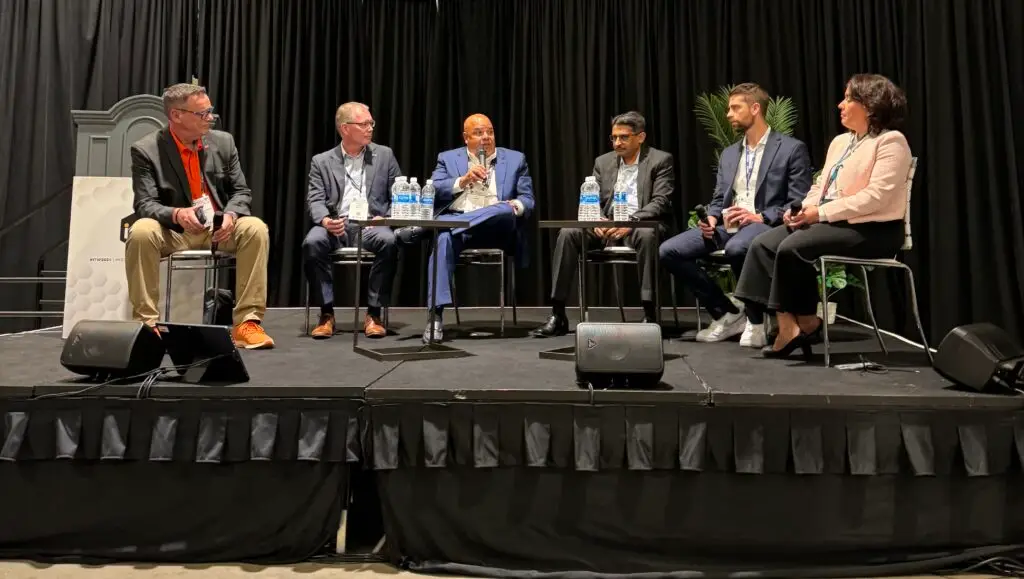Key Insights from the ITW 2024 Fishbowl Panel on Influential Subsea Routes
May 22, 2024

In a world increasingly driven by data and connectivity, the importance of robust digital infrastructure cannot be overstated. This year at International Telecoms Week (ITW) 2024 hosted by Capacity Media, industry leaders and innovators gathered for an insightful Fishbowl Panel to discuss which routes are most influential in expanding subsea connectivity — that’s 99% of all intercontinental internet traffic.
Andy Bax, Senior Partner, Digital Infrastructure – Cambridge Management Consulting (moderator)
Wilfried Dudink, Strategy & Development, Network Service Providers – Digital Realty
Gil Santaliz, CEO – NJFX
Kapil Kumar Jain, VP & Global Head Network – Tata Communications
Noah Drake, President & Managing Director – Telstra
Monica Martinez Quero, Chief Marketing Officer– Telxius
Addressing Challenges and Seizing Opportunities in Subsea Connectivity
Andy kicked off the panel with a vibrant introduction of the participants, emphasizing the comprehensive expertise gathered. “We’ve all been in the business; we’ve been there, done that. We’ve run operations, we’ve built systems, we’ve developed networks,” Andy explained. He underscored the importance of smaller cable systems, posing to the panel, “What role do they play today? What role might they play in the future?”
Monica Martinez Quero, CMO at Telxius, took the lead, articulating the significance of smaller cable systems. “These systems connect less populated areas with less demand, serving as vital links for growing markets,” Monica said. She highlighted the San Juan project, extending from Punta Cana in the Dominican Republic to Puerto Rico and onto the United States, as a pivotal development in bridging high-capacity gaps in the Caribbean.
Monica further described the Junior cable, a 390-kilometer submarine system connecting Rio de Janeiro to Santos, which plays a critical role in routing traffic from Argentina to Virginia Beach in the U.S. “These cables are a part of the bigger topology map in the industry and play a big role due to their strategic positions and capabilities,” she added.
Acknowledging Monica’s insights, Andy reflected on the broader implications. “People often think about small systems as being regional, connecting small populations. But they are a different part of the ecosystem, integral to our global infrastructure.”
Gil Santaliz, CEO of NJFX, brought to light the strategic importance of the Confluence Cable System, a pivotal infrastructure project enhancing connectivity along the East Coast of the United States. “The Confluence Cable is providing an alternate path connecting five key landing stations—Boca, Jacksonville, Myrtle Beach, Virginia Beach, and Wall, New Jersey,” Gil explained. He emphasized the system’s role in offering failover capabilities and addressing the aging infrastructure challenges traditionally handled by highways and railroads. “By avoiding the congested right-of-way issues, this system not only supports inter-country but also intra-country traffic, enhancing the technological landscape significantly,” he added.
Noah Drake, President & Managing Director at Telstra, then shifted the focus towards regional connectivity and its impact on underserved populations. “The regional systems play a critical role, especially in the South Pacific, where we bridge the digital divide through a mix of subsea, wireless, and satellite technologies,” Noah noted. Reflecting on Telstra’s acquisition of Digital South Pacific, he highlighted collaborative efforts with governments to make these projects viable, emphasizing the synergy between commercial interests and social responsibilities.
Kapil Kumar Jain, VP & Global Head Network at Tata Communications, expanded on the discussion by linking the functionality of small cable systems to broader network resilience. “On both the East and West Coasts of the U.S., these smaller systems provide crucial alternate connectivity,” Kapil pointed out. He detailed how, during simultaneous disruptions of major routes, smaller systems facilitate a mesh ecosystem that maintains network integrity. “These cables are integral to our industry’s future, potentially increasing to represent 30-40% of our ecosystem within the next five years as we aim to connect digitally divided regions,” he projected.
As the panel discussion revealed, small submarine cable systems are more than mere supplements to their larger counterparts; they are vital components that ensure robust, resilient, and inclusive global connectivity. This holistic approach not only addresses immediate logistical challenges but also paves the way for a more interconnected and equitable future.
Wilfried Dudink, Strategy & Development, Network Service Providers at Digital Realty, reflecting on the evolving landscape of connectivity hubs in the Mediterranean, emphasized the emergence of new key locations beyond the traditional hubs like Marseille. “Cities like Barcelona, Genoa, Rome, Crete, Athens, and Tel Aviv are becoming significant connectivity hubs, aided by both terrestrial and innovative subsea cable technologies,” he stated. This diversification is seen as a vital strategy for enhancing regional connectivity resilience.
Andy Bax then broadened the discussion to address the challenges facing the industry, including the shortages in cable ships and manufacturing capabilities. “We’re witnessing a surge in demand for both large-scale and small, regional interconnector cables that offer diversity,” Andy noted. He highlighted ongoing issues such as the shortage of cable ships and the slow pace of scaling up manufacturing post-COVID, which are compounded by the need for dual-purpose ships that can both install and repair cables.
Kapil contributed insights into the operational hurdles, “The balancing act between installing new cables and repairing existing ones creates a complex operational scenario. Moreover, there’s a push towards sustainability, demanding that end-to-end cable delivery aligns with eco-friendly practices.” He shed light on the aging fleet of cable ships, with many nearing the end of their service life, underscoring the need for investment in new, sustainable technologies for future developments.
The conversation then shifted towards the impact of geopolitics on the subsea cable industry, a topic further explored by Noah Drake and Gil Santaliz. Noah discussed the strategic delays and challenges posed by permitting processes and geopolitical tensions. “The industry is not just about managing physical resources but also navigating regulatory and political landscapes,” Noah explained.
Gil provided a deeper perspective on how geopolitical tensions are fostering innovation within the industry. “The demand for additional resilience has led to the development of Layer 1 SDN platforms, enabling dynamic switching between subsea cables, thus enhancing the monetization of these assets,” Gil detailed.
Wilfried added that geopolitical shifts are prompting the exploration of new routes, “The current geopolitical climate is pushing the industry to develop alternative routes, enhancing global connectivity diversity.” This includes potentially transformative routes from APAC directly to South Africa and across the Arctic.
Andy reflected on the broader implications of these challenges. “Addressing these issues isn’t just about overcoming technical obstacles but also involves enhancing cooperation between governments and private stakeholders to ensure the deployment of sustainable, resilient infrastructure.”
Adapting to the Evolving Demands of Subsea Cable Infrastructure
Kapil elaborated on the challenges faced by the industry due to recent cable damages and the complexities involved in repair processes. Highlighting the extended downtime, Kapil expressed concern over the industry’s responsiveness to unforeseen incidents, “It’s been two and a half months since the cable cuts, and without permits, we can’t even begin repairs. This situation forces us to rethink traditional routing and introduces substantial challenges but also opens opportunities for innovative solutions.”
The panel also discussed the broader implications of these delays, emphasizing the need for more robust infrastructure and faster response strategies to maintain global connectivity. Andy added perspective on the role of hyperscalers and traditional carriers in building redundancy into their networks. “Hyperscalers are pushing the boundaries, not just focusing on route diversity but also on path and system diversity, which is increasingly important as we aim to ensure resilience in our global networks,” Andy noted.
Wilfried touched upon the development of new connectivity hubs in the Mediterranean, expanding the geographic diversity and resilience of the network infrastructure. “The emergence of new hubs in locations like Barcelona and Tel Aviv represents a strategic evolution, offering alternative routes that enhance the overall robustness of our connectivity solutions,” Wilfried observed.
The conversation shifted to technological advancements that could mitigate some of these challenges. Kapil adding that the deployment of Layer 1 SDN might revolutionize how traffic is managed across these networks. “With SDN technology, we can automate the rerouting process, which currently relies heavily on manual intervention. This could significantly enhance our operational efficiency and reduce downtime during outages,” he proposed.
Andy directed the panel’s attention towards future developments in fiber technology and system capacity. “As we build larger cables with higher fiber counts, we need to consider the long-term implications of these developments on our networks and the global connectivity landscape. How do we manage the increased capacity, and what does it mean for the overall durability of our infrastructure?” Andy questioned.
The panelists discussed the potential for multicore fiber technologies to double the capacity of existing systems without adding more fiber pairs, a critical consideration as the industry seeks to expand capacity while managing the complexities of repair and maintenance.
The panelists delved deeper into the technical, operational, and geopolitical challenges facing the subsea cable industry, exploring strategies to navigate these complexities while fostering innovation and resilience in global connectivity.
The Future of Transatlantic and Global Subsea Networks
Kapil highlighted the ongoing and future challenges in the transatlantic routes, noting the proliferation of new, high-capacity cables. “As we look to the next three to four years, we may see multiple cables with 16 to 25 fiber pairs becoming available in the Transatlantic. However, integrating these cables to create a resilient network remains a puzzle, particularly in Europe,” Kapil reflected. He emphasized the need for innovative solutions to interconnect these diverse routes to ensure robust and redundant network architectures.
Andy responded to Kapil’s insights, focusing on the necessity for direct fiber restoration over mere capacity routing. “What Confluence is aiming to do on the East Coast of the U.S. needs to be mirrored along the entire coast of Europe to ensure seamless fiber restoration,” Andy added, underscoring the importance of comprehensive connectivity solutions that can adapt to unexpected disruptions.
Wilfried shared a specific example from Crete, where multiple cable landing stations are being connected to a central facility to facilitate switching between cables, enhancing network flexibility and resilience. “The project in Crete reflects a broader necessity for integrated infrastructure that can support the dynamic needs of the subsea community,” Wilfried noted.
The panel then opened the floor to questions from the audience, leading to a lively discussion about the investment challenges and educational gaps surrounding subsea cable systems. Andy tackled the overarching challenges facing the subsea community, particularly the need to elevate the industry’s profile to attract investment and governmental support.
Gil addressed the logistical and environmental challenges of deploying subsea cables, highlighting the delicate balance between development and local regulations. “The pushback from local communities and the high costs imposed by municipalities can significantly complicate development efforts,” Gil explained.
The session concluded with a consensus on the critical role of education and collaboration in overcoming the challenges faced by the subsea cable industry. The panelists underscored the importance of raising awareness about the strategic value of subsea cables and fostering partnerships to support sustainable and resilient infrastructure development.

